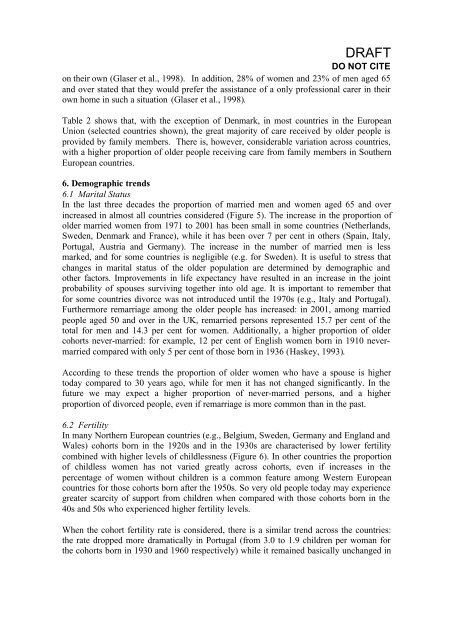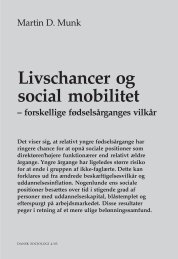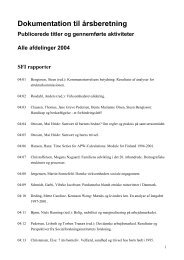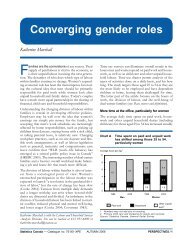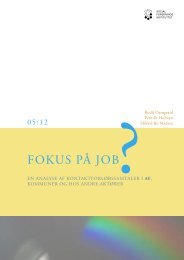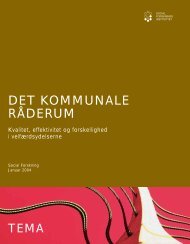Living Arrangements and Care Receipt Among Older People - SFI
Living Arrangements and Care Receipt Among Older People - SFI
Living Arrangements and Care Receipt Among Older People - SFI
Create successful ePaper yourself
Turn your PDF publications into a flip-book with our unique Google optimized e-Paper software.
DRAFT<br />
DO NOT CITE<br />
on their own (Glaser et al., 1998). In addition, 28% of women <strong>and</strong> 23% of men aged 65<br />
<strong>and</strong> over stated that they would prefer the assistance of a only professional carer in their<br />
own home in such a situation (Glaser et al., 1998).<br />
Table 2 shows that, with the exception of Denmark, in most countries in the European<br />
Union (selected countries shown), the great majority of care received by older people is<br />
provided by family members. There is, however, considerable variation across countries,<br />
with a higher proportion of older people receiving care from family members in Southern<br />
European countries.<br />
6. Demographic trends<br />
6.1 Marital Status<br />
In the last three decades the proportion of married men <strong>and</strong> women aged 65 <strong>and</strong> over<br />
increased in almost all countries considered (Figure 5). The increase in the proportion of<br />
older married women from 1971 to 2001 has been small in some countries (Netherl<strong>and</strong>s,<br />
Sweden, Denmark <strong>and</strong> France), while it has been over 7 per cent in others (Spain, Italy,<br />
Portugal, Austria <strong>and</strong> Germany). The increase in the number of married men is less<br />
marked, <strong>and</strong> for some countries is negligible (e.g. for Sweden). It is useful to stress that<br />
changes in marital status of the older population are determined by demographic <strong>and</strong><br />
other factors. Improvements in life expectancy have resulted in an increase in the joint<br />
probability of spouses surviving together into old age. It is important to remember that<br />
for some countries divorce was not introduced until the 1970s (e.g., Italy <strong>and</strong> Portugal).<br />
Furthermore remarriage among the older people has increased: in 2001, among married<br />
people aged 50 <strong>and</strong> over in the UK, remarried persons represented 15.7 per cent of the<br />
total for men <strong>and</strong> 14.3 per cent for women. Additionally, a higher proportion of older<br />
cohorts never-married: for example, 12 per cent of English women born in 1910 nevermarried<br />
compared with only 5 per cent of those born in 1936 (Haskey, 1993).<br />
According to these trends the proportion of older women who have a spouse is higher<br />
today compared to 30 years ago, while for men it has not changed significantly. In the<br />
future we may expect a higher proportion of never-married persons, <strong>and</strong> a higher<br />
proportion of divorced people, even if remarriage is more common than in the past.<br />
6.2 Fertility<br />
In many Northern European countries (e.g., Belgium, Sweden, Germany <strong>and</strong> Engl<strong>and</strong> <strong>and</strong><br />
Wales) cohorts born in the 1920s <strong>and</strong> in the 1930s are characterised by lower fertility<br />
combined with higher levels of childlessness (Figure 6). In other countries the proportion<br />
of childless women has not varied greatly across cohorts, even if increases in the<br />
percentage of women without children is a common feature among Western European<br />
countries for those cohorts born after the 1950s. So very old people today may experience<br />
greater scarcity of support from children when compared with those cohorts born in the<br />
40s <strong>and</strong> 50s who experienced higher fertility levels.<br />
When the cohort fertility rate is considered, there is a similar trend across the countries:<br />
the rate dropped more dramatically in Portugal (from 3.0 to 1.9 children per woman for<br />
the cohorts born in 1930 <strong>and</strong> 1960 respectively) while it remained basically unchanged in


